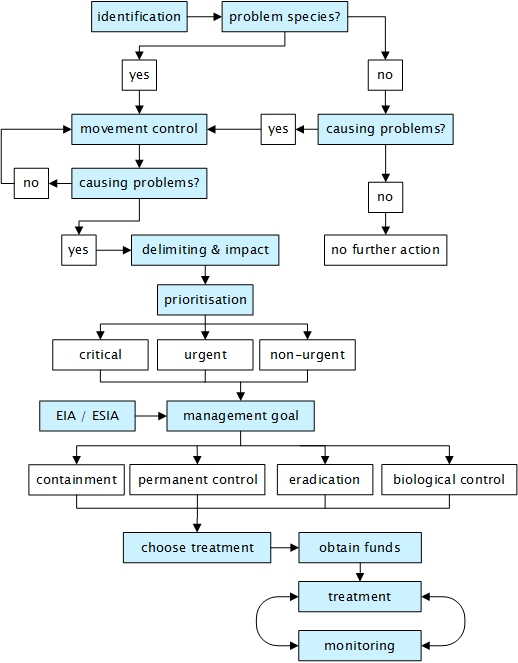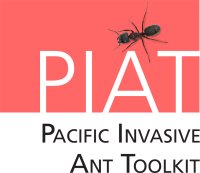Getting rid of ants
Whether your ant problem is large or small, this section helps you decide how to solve it.
As ants often cause problems when they are involved in mutualisms with pest insects, it is wise to combine ant control with control of these pests.
PestNet has a comprehensive range of resources for managing pests. You can browse PestNet for factsheets and other information. These factsheets are particularly useful to find out how to deal with mutualists of ants, such as mealybugs.
Large-scale problems : Small-scale problems
Large-scale problems
When ants are infesting a large area, small-scale do-it-yourself off-the-shelf solutions are ineffective. Large-scale ant management operations need to be well defined and planned, well-funded and supported and highly organised.
High level planning
Large scale management of ant incursions is a costly and challenging process. Many planning decisions need to be made before the first application of bait.
|
Click on the shaded boxes in the flowchart to find out more detail about planning large scale management. Management decisions should be based on an accurate identification of the ant species, because not all ants will respond in the same way to a particular bait. If it is identified as a problem species (or it is causing concern or impacts), movement controls should be implemented immediately. The area the ant infests should be delimited and action prioritised. Are the problems the ant is causing sufficient to warrant the cost of removing it? If the answer is yes, how urgently does the problem need to be addressed? Little fire ant or red imported fire ant incursions are an emergency, so seek help early. It is essential that management goals are clearly defined. Environmental and social impacts should be considered and decisions agreed with all stakeholders. Once the appropriate treatment is chosen costs need to be estimated, including bait, labour, transport, equipment and any compensation that needs to be paid to affected parties. A management plan should be drafted including all of these elements. We have devised a management plan template that you can use. This will be important for funders as they will want to know the work has been well thought out. |
 |
If your problem species is not one of the worst 5, there is little management information available, so as well as working through the flow chart, read about managing other ants.
Applying for funding can be time-consuming and should be addressed as soon as possible. Clearly defined objectives, budget breakdowns, an environmental risk assessment and a thorough management plan will speed the process along.
From there, the plan is actioned, through treatment and monitoring.
Further reading on planning
SPC issued a general emergency response plan for invasive ant incursions which details an incursion response from initial detection.
For formalised project management tools for invasive species management from project selection through to sustaining the project visit the Pacific Invasives Initiative website.
Small-scale problems
When ants are infesting a small area or only causing problems around the home environment, there are some simple, low-cost and effective options for management.
- non-toxic options - although dealing with ant problems is a hassle, there are a number of things you can do to reduce the effects of the ants at little or no cost
- off-the-shelf solutions for households - a number of commercial products are available to treat small ant infestations around the home
- the Hawai'i Ant Lab has a how to guide for managing little fire ants around the home (Please note that Hawai'i Ant Lab periodically updates their fact sheets, go to the Hawai'i Ant Lab website to check for updated versions)
